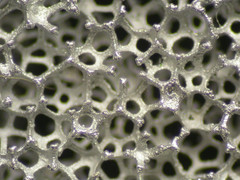Sumitomo Electric Industries Ltd (SEI) is the Japanese company behind this innovation. If you haven’t heard of SEI before, it is an electric wire and optical fiber cable manufacturer that recently developed a porous aluminum dubbed Aluminum-Celmet.
The new metal can be integrated into current Li-ion rechargeable batteries and provide greater battery capacity. Its three-dimensional structure reportedly forms interconnected, spherical pores that can be modulated by cutting and stamping. In addition, Aluminum-Celmet’s gravity and electrical resistivity are considerably lower than those of Celmet, which is a metal, derived from Nickel and currently used by SEI when manufacturing NiMH batteries for hybrid vehicles.
Apparently, standard Li-ion batteries are often made by Aluminum and Cu (copper) foils and by replacing the Al foil with Aluminum-Celmet, the rechargeable Li-ion battery can have 1.5 to 3 times greater capacity.
Sumitomo Electric Industries is supposedly setting up a production line at Osaka Works and plans to accelerate the development process and move to mass production.
Recently, scientists at the Royal Melbourne Institute of Technology (RMIT) in Australia managed to typify the capability of piezoelectric thin films to generate electricity via mechanical pressure. This is another innovation that will provide longer battery life by allowing consumers to charge their devices by just typing or touching the screen.
It appears that very soon we might be buying notebooks that offer 40-50 hours of battery life or at least ones that can be charged without an AC unit.
Source(s)
http://www.eweekeurope.co.uk/news/porous-aluminium-could-boost-battery-life-32849
http://www.expertreviews.co.uk/general/1285687/aluminium-celmet-promises-major-battery-boost
http://notebookitalia.it/aluminium-celmet-per-batterie-dalla-lunga-autonomia-12017
http://notebookitalia.it/images/stories/aluminium_celmet.jpg


 Deutsch
Deutsch English
English Español
Español Français
Français Italiano
Italiano Nederlands
Nederlands Polski
Polski Português
Português Русский
Русский Türkçe
Türkçe Svenska
Svenska Chinese
Chinese Magyar
Magyar